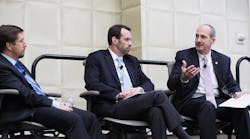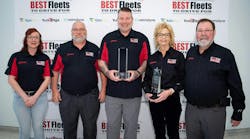Potential new regulations requiring safety-sensitive transportation workers such as truck drivers to be screened for obstructive sleep apnea (OSA) are bringing out strong opinions and points for and against. And regarding OSA treatment, have you heard of truck drivers setting an alarm each night for the minimum required time to be compliant with PAP machine therapy so they can wake up and rip it off?
If a commercial vehicle driver has been diagnosed with OSA, he or she must maintain 70% compliance with treatment, which most often is the use of a positive airway pressure (PAP) machine. Treatment requires at least four hours of use a night, so 70% compliance means the driver needs to use the machine that long for seven out of every 10 days.
An eyebrow-raising conversation on the matter took place several weeks before the Federal Motor Carrier Safety Administration's (FMCSA) joint release with the Federal Railroad Administration of a notice seeking public comments on potential OSA screening, evaluation and treatment regulations. This particular discussion was in Dallas during fleet technology company Omnitracs' annual user conference, and an FMCSA representative was there; so was one from the American Trucking Assns. (ATA).
And so was Steve Page, vice president of safety at Joplin, MO-based dry van carrier Transport Distribution Co. He was part of a panel covering various regulatory issues, and sleep apnea screening and treatment came up. "You find that some of these drivers learn that to be compliant, they've got to go 4 hrs. each night. So what do they do? They set an alarm clock for 4 hrs. 15 min. from when they go to sleep, so they can wake up and take it [their PAP machine] off because they hate it so bad," Page said.
"Obviously, to me, that's not good; you're not getting your full sleep," he added. "We've got some work to do on this."
Page noted that there are multiple risk factors for having OSA, and people often focus solely on being overweight, a common problem among truck drivers. Having more weight around the neck puts additional pressure on airways and thus can contribute to breathing obstruction. Even so, it's not just weight but genetics and other factors such as high blood pressure that indicate a person is at higher risk for OSA, Page pointed out, and those come into play when Transport Distribution determines if drivers may need a sleep apnea test.
He also noted that the company has used sleep testing devices that drivers can take home or wherever they normally sleep. That's often better than a lab-based test, where "they plug all these things on you, lay you in a bed you're not used to and say, 'Sleep,'" Page contended. "That's pretty tough to do."
While many people have heard of CPAP machines, which provide a constant airway pressure, they often haven't heard of other types such as BiPAP, Page said, which refers to a bi-level pressure device that can have a higher pressure for inhaling and lower pressure to allow easier exhaling. Another type is an APAP, which is an automatically adjusting pressure device; PAP machines also have different sizes and types of masks.
So as FMCSA considers requiring OSA screening, it appears there's a good deal of variation in sleep testing methods, PAP machines themselves and overall knowledge about OSA. And costs also are a factor, Page noted during the panel discussion, since new drivers might be tested early on before they've fulfilled a health insurance coverage period requirement, or they as well as long-term employees may have to meet an out-of-pocket deductible.
ATA's Rob Abbott, vice president of safety policy, noted that getting substantive feedback is a part of the advanced notice of public rulemaking process. "We're aware of the problems some of the drivers have had with their devices," he said, "but if you talk to drivers who've used a PAP machine, though they might've been reluctant initially, many of them glow about the benefits."
Indeed, several attendees of the session then shared their own experiences with PAP machine therapy, and all who did said it had helped them. "I owe my life to it today, because I had massive heart problems from not using a PAP machine. But once I got using it, it leveled the problems out," one attendee said. Added another: "I couldn't believe the energy I had. Yes, it's a mask on your face, but you can get used to it; I'm awake right now because of it."
Still another, emphasizing that weight isn't the only factor involved in OSA since he'd been thin when diagnosed with it, pointed out he can sleep sitting up and not even need a PAP machine. But he also claimed "a lot of these medical examiners out there don't know what the hell to do" in terms of running a sleep test.
"Once the genie's out of the bottle, it's out there," the attendee quipped regarding a potential requirement for OSA screening for drivers. "We can't just set a rule based on someone's opinion that all fat people need this."
Public comments
Comments that FMCSA has received about requiring OSA screening thus far have been very polarized, with some touting positive health and safety benefits of diagnosing and treating the problem. "I believe that [the U.S. Department of Transportation]/FMCSA should institute regulatory requirements and parameters for sleep apnea testing for prospective and renewal drivers requiring medical certification," states one physician commenter.
"While OSA testing and treatment is expensive and cumbersome, public safety and the safety of our drivers is our primary concern," the commenter adds. "We need to have reasonable, evidence-based regulations that are required and enforced across the board for all drivers and medical examiners."
Other comments aren't nearly as supportive. Dozens of commenters — many of whom claim to be current or former truck drivers — call required OSA screening things like "a scam," an "un-American" infringement upon their rights or stronger descriptors. Some warn that mandatory OSA testing and treatment will likely put a heavy cost burden on drivers.
"Some medical examiners will not give a temporary physical card to a driver until he can make arrangements to have a sleep study performed. This essentially puts the driver out of work," states a commenter. "Then when he does make arrangements for the test, he finds out that his health insurance does not cover the test. Testing prices range from $2,500 to $4,000.
"The thing that I find interesting is that all of the sleep studies that I have seen submitted to the FMCSA are funded by the same companies that provide the medical equipment for the studies themselves," the commenter continues.
Although comments regarding OSA screening tend to be either emphatically for or against, one thing both positive and negative commenters mention is consistency. "Anyone can be afflicted with sleep apnea, not just overweight or large-necked folks," a commenter states. "So if you are not testing everyone, this whole rule is disingenuous."



